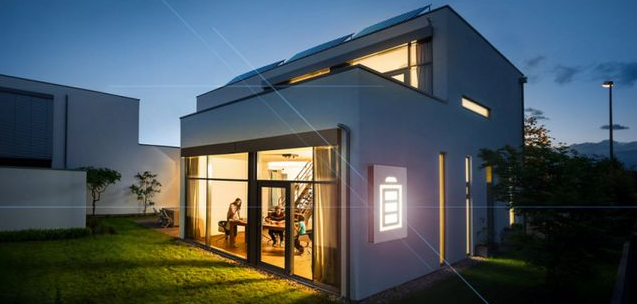Driven by the goal of carbon neutrality, future energy use will increasingly shift towards clean energy. Solar energy, as a common clean energy in daily life, will also receive more and more attention. However, the energy supply of solar energy itself is not stable, and is closely related to the intensity of sunlight and weather conditions of the day, which requires a set of suitable photovoltaic energy storage equipment to regulate energy.
The Heart of a Home Photovoltaic System
Home photovoltaic energy storage is usually installed in combination with home photovoltaic systems to provide electricity to home users. The energy storage system can improve the degree of self-use of household photovoltaics, reduce the user’s electricity bill, and ensure the stability of the user’s electricity consumption under extreme weather conditions. For users in areas with high electricity prices, peak-to-valley price differences, or old grids, it is more economical to purchase household storage systems, and household users have the motivation to purchase household storage systems.
At present, most of the solar energy used in China is only used for water heaters. Solar panels that can really supply electricity for the whole house are still in their infancy, and the main users are still overseas, especially in Europe and the United States.
Due to the high degree of urbanization in European and American countries, and the housing is usually dominated by independent or semi-independent houses, it is suitable for the development of household photovoltaics. According to statistics, in 2021, the EU’s per capita household photovoltaic installed capacity will be 355.3 watts per household, a 40% increase compared with 2019.
In terms of penetration rate, the installed capacity of household photovoltaics in Australia, the United States, Germany and Japan account for 66.5%, 25.3%, 34.4% and 29.5% of the total installed photovoltaic capacity respectively, while the proportion of installed photovoltaic capacity in households in China is only 4%. Left and right, with great room for development.
The core of the household photovoltaic system is the energy storage equipment, which is also the part with the largest cost. At present, the price of lithium batteries in China is about 130 US dollars/kWh. Taking a family of four in Sydney whose parents are working class as an example, assuming that the daily power consumption of the family is 22kWh, the installed home energy storage system is 7kW photovoltaic components plus a 13.3kWh energy storage battery. This also means that just enough energy storage batteries for a photovoltaic system will cost $1,729.
But in the past few years, the price of home solar equipment has dropped by about 30% to 50%, while the efficiency has increased by about 10% to 20%. This is expected to accelerate the rapid development of household photovoltaic energy storage.
Bright prospects for household photovoltaic energy storage
In addition to energy storage batteries, the rest of the core equipment are photovoltaics and energy storage inverters, and home energy storage systems can be divided into hybrid home photovoltaic energy storage systems and coupled home photovoltaic energy storage systems according to different coupling methods and whether they are connected to the grid. system, off-grid home photovoltaic energy storage system, and photovoltaic energy storage energy management system.
Hybrid household photovoltaic energy storage systems are generally suitable for new photovoltaic households, which can still guarantee electricity demand after a power outage. It is currently the mainstream trend, but it is not suitable for upgrading existing photovoltaic households. The coupling type is suitable for existing photovoltaic households, transforming the existing grid-connected photovoltaic system into an energy storage system, the input cost is relatively low, but the charging efficiency is relatively low; the off-grid type is suitable for areas without grids, and usually needs to be equipped with diesel generators interface.
Compared with energy storage batteries, inverters and photovoltaic modules account for only about half of the overall cost of batteries. In addition, household energy storage products need to be installed by installers, and the installation cost is also 12%-30%.
Although more expensive, many battery storage systems also allow intelligent scheduling of electricity in and out, not only to sell excess power to the power system, but some are optimized for integration into electric vehicle charging facilities. At the moment when electric vehicles are becoming more and more popular, this advantage will also help users save a lot of costs.
At the same time, excessive dependence on external energy sources will lead to an energy crisis, especially in today’s tense global situation. Taking Europe’s energy structure as an example, natural gas accounts for as much as 25%, and European natural gas is very dependent on imports, which leads to the urgent need for energy transformation in Europe.
Germany has advanced the target of 100% renewable energy power generation from 2050 to 2035, achieving 80% of energy from renewable energy power generation. The European Commission passed the REPowerEU proposal to increase the EU’s renewable energy goals for 2030, which will increase 17TWh of electricity in the first year of the household photovoltaic plan, and generate 42TWh of additional electricity by 2025. All public buildings are equipped with photovoltaics, and require All new buildings are installed with photovoltaic roofs, and the approval process is controlled within three months.
Calculate the installed capacity of distributed photovoltaics based on the number of households, consider the penetration rate of household energy storage to obtain the number of installed household energy storage, and assume the average installed capacity per household to obtain the installed capacity of household energy storage in the world and in various markets.
Assuming that in 2025, the penetration rate of energy storage in the new photovoltaic market is 20%, the penetration rate of energy storage in the stock market is 5%, and the global household energy storage capacity space reaches 70GWh, the market space is huge.
summary
As the proportion of clean electric energy in daily life becomes more and more important, photovoltaics have gradually entered thousands of households. The home photovoltaic energy storage system can not only meet the daily electricity demand of the household, but also sell the excess electricity to the grid for income. With the increase of electrical equipment, this system may become a must-have product in future families.
Post time: Aug-30-2023









